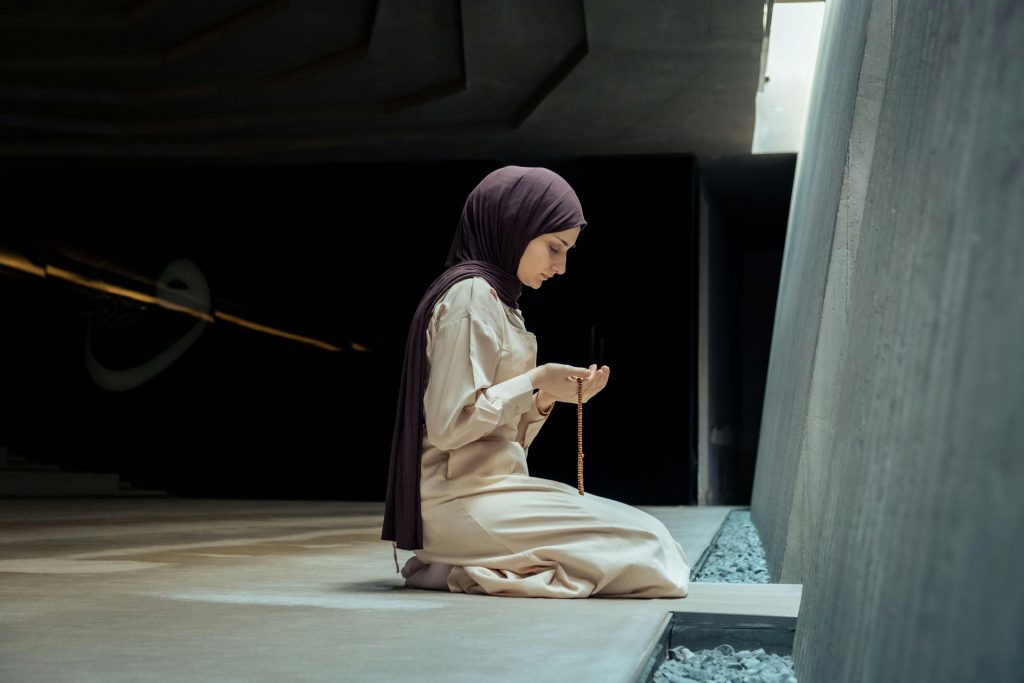Table of Contents
ToggleWhat Is Tashahhud in English?
Tashahhud in English is the heartfelt testimony recited during Salah, affirming our belief in Allah and the Prophet ﷺ. It’s a key part of every Muslim’s prayer, holding deep meaning in every word — from “Ashhadu an la ilaha illallah” to “wa ashhadu anna Muhammadan abduhoo wa rasooluh”. Learn how to recite it with correct meaning, pronunciation, and spiritual depth.
Tashahhud in Arabic
Here’s how it is recited in Arabic:
اَلتَّحِيَّاتُ لِلَّهِ وَالصَّلَوَاتُ وَالطَّيِّبَاتُ، السَّلَامُ عَلَيْكَ أَيُّهَا النَّبِيُّ وَرَحْمَةُ اللَّهِ وَبَرَكَاتُهُ، السَّلَامُ عَلَيْنَا وَعَلَىٰ عِبَادِ اللَّهِ الصَّالِحِينَ، أَشْهَدُ أَنْ لَا إِلَٰهَ إِلَّا اللَّهُ، وَأَشْهَدُ أَنَّ مُحَمَّدًا عَبْدُهُ وَرَسُولُهُ
Tashahhud Transliteration
At-tahiyyātu lillāhi was-salawātu waṭ-ṭayyibāt.
As-salāmu ʿalayka ayyuhan-nabiyyu wa raḥmatullāhi wa barakātuh.
As-salāmu ʿalaynā wa ʿalā ʿibādillāhiṣ-ṣāliḥīn.
Ash-hadu an lā ilāha illallāh
wa ash-hadu anna Muḥammadan ʿabduhū wa rasūluh.
Tashahhud in English (Meaning)
“All greetings, prayers, and goodness are for Allah.
Peace be upon you, O Prophet, and the mercy of Allah and His blessings.
Peace be upon us and upon the righteous servants of Allah.
I bear witness that there is no god but Allah,
and I bear witness that Muhammad is His servant and messenger.”
Why Is Tashahhud So Important in Salah?
Because it’s where your voice trembles with both love and submission.
While standing, we glorify. While bowing, we show humility. But while sitting in Tashahhud — we testify.
This is the part of Salah where you are not asking, but acknowledging. You’re telling your Lord: I believe in You. I believe in Your Messenger. I send peace to him. And I want peace for every righteous soul who bows in worship.
It’s intimate.
It’s raw.
It’s beautiful.

The Spiritual Layers Hidden in Tashahhud
Let’s break down each line with heart.
1. “All greetings, prayers, and goodness are for Allah”
Here, we return every noble word, every blessed prayer, every pure act — to Him alone. It’s a deep recognition that all goodness begins and ends with Allah.
2. “Peace be upon you, O Prophet”
Even in our most private act of devotion, we remember the one who taught us how to pray. We send peace directly to the Messenger ﷺ — by name, with love.
3. “Peace be upon us and upon the righteous servants of Allah”
This is where we ask for peace not just for ourselves, but for every righteous servant — past, present, and future. It connects you to a global brotherhood of believers.
4. “I bear witness…”
This isn’t a light statement.
It’s the Shahadah — the foundation of your Islam. To recite it here, again and again, in every prayer, is to renew your faith. To reconfirm your love for Allah and His Prophet ﷺ.
The Power of Tashahhud for the Soul
If you’ve ever prayed while broken, you know that Tashahhud feels different in those moments.
It becomes the place where tears fall quietly.
Where your back finally straightens after hardship.
Where your tongue, dry from grief, suddenly tastes sweetness.
Some scholars say: this part of the prayer is so beloved that even the angels gather to hear it.
Because it’s not just about what you say. It’s about how you feel when you say it.
When Is Tashahhud Recited in Salah?
There are two types of Tashahhud:
-
First Tashahhud (after two rak’ahs) – In Salahs of 3 or 4 units, like Maghrib or Dhuhr, it’s recited midway.
-
Final Tashahhud (before concluding Salah) – This is recited in the last sitting, followed by salawat (Durud Ibrahim) and the tasleem (saying salam).
Can I Say Tashahhud in English?
If you are still learning Arabic and genuinely struggle with pronunciation, scholars allow praying in your native language during the early stages of learning. But Arabic should always be the goal, since the Salah is preserved in its original form.
The Prophet ﷺ recited it in Arabic, and there’s a spiritual weight to the language that translations can’t fully carry.
Tashahhud Teaches Us Humility
What makes Tashahhud so profound is that it silences the ego.
In this moment, you’re not thinking of your job, your status, or your plans.
You’re just a soul, sitting before its Creator, bearing witness.
It’s where you remember:
You were created to worship.
You were guided to truth.
And you were never alone in your prostration.
Related Questions (FAQs)
What is the English version of the Tashahhud?
The English version of Tashahhud is:
“All greetings, prayers, and goodness are for Allah. Peace be upon you, O Prophet, and the mercy of Allah and His blessings. Peace be upon us and upon the righteous servants of Allah. I bear witness that there is no god but Allah, and I bear witness that Muhammad is His servant and messenger.”
It is recited during Salah as a declaration of faith and reverence.
What do I say in Tashahhud during prayer?
In Tashahhud, you say the full Attahiyat, which includes phrases of praise for Allah, peace upon the Prophet ﷺ, and the testimony of faith. It starts with:
“Attahiyyatu lillahi was-salawatu wat-tayyibat…”
This is said while sitting in the second and last units of prayer (rakahs).
Can I say Attahiyat in English while praying?
If you’re learning or struggling, many scholars allow beginners to say Attahiyat in English until they memorize the Arabic. But eventually, it’s important to learn it in Arabic, as Salah is meant to be recited in the language of the Quran.
What is the full Tashahhud dua in Arabic?
The full Tashahhud in Arabic is:
“التحيات لله والصلوات والطيبات، السلام عليك أيها النبي ورحمة الله وبركاته، السلام علينا وعلى عباد الله الصالحين، أشهد أن لا إله إلا الله، وأشهد أن محمدًا عبده ورسوله.”
It is recited in every Salah during the sitting position.
What is the Tashahhud translation in Urdu?
Tashahhud in Urdu means:
“تمام قولی، فعلی اور مالی عبادات اللہ کے لیے ہیں۔ اے نبی! آپ پر سلامتی، اللہ کی رحمت اور برکتیں ہوں۔ ہم پر اور اللہ کے نیک بندوں پر سلام ہو۔ میں گواہی دیتا ہوں کہ اللہ کے سوا کوئی معبود نہیں، اور میں گواہی دیتا ہوں کہ محمدﷺ اللہ کے بندے اور رسول ہیں۔”
It brings depth to the understanding of your prayer.
What is the difference between Tashahhud 1 and Tashahhud 2?
Tashahhud 1 is recited after the second rakah in a 3- or 4-unit Salah.
Tashahhud 2 is recited in the last rakah and includes the Salawat (Durood) after the testimony part. It is the more complete version.
Which prayers include two Tashahhuds?
Salah with three or four rakahs (like Dhuhr, Asr, Maghrib, Isha) include two Tashahhuds. One comes after the second rakah, and the second in the last sitting before ending the prayer.
Where does Tashahhud come in Namaz?
Tashahhud is recited while sitting after the second rakah and again at the end of the final rakah in longer prayers. It is the part where we silently reflect and connect with Allah.

Final Reflection — Let Tashahhud Heal You
Next time you sit in prayer, don’t rush.
Slow down.
Let every syllable of Tashahhud roll off your tongue like poetry. Let your heart feel the truth of your testimony.
This is not just a routine. It’s a moment of presence. A meeting with the Most Merciful. A declaration that you still believe, still love, still hope.
And in a world that tries to shake your faith — this is where you hold it firm.
Learn More With Taqweem Academy
If this article touched your heart, explore more of our resources at Taqweem Academy. We’re here to help Muslims — new and old — connect deeply with their Deen, one verse and one prayer at a time.
Join our newsletter for weekly spiritual insights
Explore our Salah course for beginners and reverts
Ask our scholars your questions in our Q&A section






